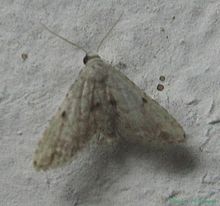Araeopteron is a genus of moths of the family Erebidae. The genus was erected by George Hampson in 1893.[2]
| Araeopteron | |
|---|---|

| |
| Araeopteron papaziani | |
| Scientific classification | |
| Domain: | Eukaryota |
| Kingdom: | Animalia |
| Phylum: | Arthropoda |
| Class: | Insecta |
| Order: | Lepidoptera |
| Superfamily: | Noctuoidea |
| Family: | Erebidae |
| Subfamily: | Boletobiinae |
| Genus: | Araeopteron Hampson, 1893 |
| Synonyms[1] | |
| |
Taxonomy
editThe genus has previously been classified in the subfamily Araeopteroninae within Erebidae or in the subfamily Acontiinae of the family Noctuidae.[3][4]
Description
editPalpi slender and sickle shaped, reaching just above the vertex of the head. Antennae almost simple. Thorax and abdomen smoothly scaled. Tibia naked. Forewings rather long and narrow. The apex rounded. Veins 3, 4 and 8, 9, 10, 11 stalked, whereas veins 6 arise from below angle of cell and vein 7 from angle. Hindwings with veins 3, 4 and 6, 7 stalked. Vein 5 from middle of discocellulars.[5][6]
Species
edit- Araeopteron acidalica Hampson, 1910
- Araeopteron adeni Fibiger & Hacker, 2001
- Araeopteron alboniger Fibiger & Hacker, 2001
- Araeopteron amoena Inoue, 1958
- Araeopteron aulombardi Fibiger & Hacker, 2001
- Araeopteron betie Dyar, 1914
- Araeopteron canescens Walker, 1866
- Araeopteron dawai Han & Kononenko, 2021
- Araeopteron diehli Fibiger, 2002
- Araeopteron ecphaea Hampson, 1914
- Araeopteron elam Schaus, 1911
- Araeopteron epiphracta Turner, 1902
- Araeopteron fasciale Hampson, 1896
- Araeopteron flaccida Inoue, 1958
- Araeopteron fragmenta Inoue, 1965
- Araeopteron goniophora Hampson, 1907
- Araeopteron griseata Hampson, 1907
- Araeopteron imbecilla Turner, 1933
- Araeopteron koreana Fibiger & Kononenko, 2008
- Araeopteron kurokoi Inoue, 1958
- Araeopteron legraini Bippus, 2018
- Araeopteron leucoplaga Hampson, 1910
- Araeopteron makikoae Fibiger & Kononenko, 2008
- Araeopteron medogensis Han & Kononenko, 2021
- Araeopteron micraeola (Meyrick, 1902
- Araeopteron microclyta Turner, 1920
- Araeopteron minimale Freyer, 1912
- Araeopteron nebulosa Inoue, 1965
- Araeopteron nivalis Hampson, 1907
- Araeopteron obliquifascia Joanis, 1910
- Araeopteron papaziani Guillermet, 2009
- Araeopteron pictale Hampson, 1893
- Araeopteron pleurotypa Turner, 1902
- Araeopteron poliobapta Turner, 1925
- Araeopteron poliophaea (Hampson, 1910)
- Araeopteron proleuca Hampson, 1907
- Araeopteron rufescens Turner, 1910
- Araeopteron schreieri Fibiger & Hacker, 2001
- Araeopteron sterrhaoides Fibiger & Hacker, 2001
- Araeopteron tibeta Han & Kononenko, 2021
- Araeopteron vilhelmina Dyar, 1916
- Araeopteron xanthopis Hampson, 1907
- Araeopteron yemeni Fibiger & Hacker, 2001
References
edit- ^ Savela, Markku, ed. (June 14, 2020). "Araeopteron Hampson, 1893". Lepidoptera and Some Other Life Forms. Retrieved October 6, 2020.
- ^ Pitkin, Brian & Jenkins, Paul (November 5, 2004). "Araeopteron Hampson, 1893". Butterflies and Moths of the World. Natural History Museum, London. Retrieved October 6, 2020.
- ^ Zahiri, Reza; et al. (2011). "Molecular phylogenetics of Erebidae (Lepidoptera, Noctuoidea)". Systematic Entomology. 37: 102–124. doi:10.1111/j.1365-3113.2011.00607.x. S2CID 84249695.
- ^ Lafontaine, J. Donald; Schmidt, B. Christian (2013). "Additions and corrections to the check list of the Noctuoidea (Insecta, Lepidoptera) of North America north of Mexico". ZooKeys (264): 227–236. doi:10.3897/zookeys.264.4443. PMC 3668382. PMID 23730184.
- ^ Hampson, G. F. (1895). The Fauna of British India, Including Ceylon and Burma: Moths Volume III. Taylor and Francis – via Biodiversity Heritage Library.
- ^ Hampson, G. F. (1896). The Fauna of British India, Including Ceylon and Burma: Moths Volume IV. Taylor and Francis. p. 543 – via Biodiversity Heritage Library.
- Dyar (1914). Proceedings of the United States National Museum 47: 184.
- Dyar (1916). Proceedings of the United States National Museum 51: 18.
- Hampson (1893). Illustrations of Typical Specimens of Lepidoptera Heterocera in the Collection of the British Museum 9: 33.
- Hampson (1907). Journal of the Bombay Natural History Society 17: 670–672.
- Hampson (1910). Catalogue of the Lepidoptera Phalaenae in the British Museum 10: 22, fig. 9.
- Hampson (1910). Catalogue of the Lepidoptera Phalaenae in the British Museum 10: 27.
- Hampson (1910). Catalogue of the Lepidoptera Phalaenae in the British Museum 10: 29. pl. 149: 19.
- Hampson. Annals and Magazine of Natural History 8(13): 167.
- Han HL, Kononenko VS (2021) Three new species of the genus Araeopteron Hampson, 1893 (Lepidoptera, Erebidae, Boletobiinae) from the Xizang Autonomous Region, China with an updated list of the world species. ZooKeys 1060: 17-32.
- Fibiger, M. (2002). Heterocera Sumatrana 12(3): 129.
- Fibiger, M. & Hacker, H.H. (2001). Esperiana Buchreie zur Entomologie 8: 1–944.
- Fibiger, M. & Kononenko, V. (2008). "A revision of the subfamily Araeopteroninae Fibiger, 2005 in the Russian Far East and neighbouring countries with a description of four new species (Lepidoptera, Noctuidae)." Zootaxa 1891: 39–54.
- Freyer (1912). Transactions of the Linnean Society of London (Zool) 15(1): 11.
- Inoue (1958). Tinea 4: 229–230.
- Inoue (1965). Tinea 7: 81.
- Joanis (1910). Bulletin de la Société Entomologique de France 1910: 201.
- Meyrick (1902). Transactions of the Entomological Society of London 35: 36.
- Schaus (1911). Annals and Magazine of Natural History 8(8): 108
- Turner (1902). Proceedings of the Linnean Society of New South Wales 27: 132–133.
- Turner (1910). Catalogue of the Lepidoptera Phalaenae in the British Museum 10: 27.
- Turner (1920). Transactions and Proceedings of the Royal Society of South Australia 44: 161.
- Turner (1925). Transactions and Proceedings of the Royal Society of South Australia 44: 39.
- Turner (1933). Transactions and Proceedings of the Royal Society of South Australia 57: 161.
- Walker (1866). Illustrations of Typical specimens of Lepidoptera Heterocera in the Collection of the British Museum 34: 1318.